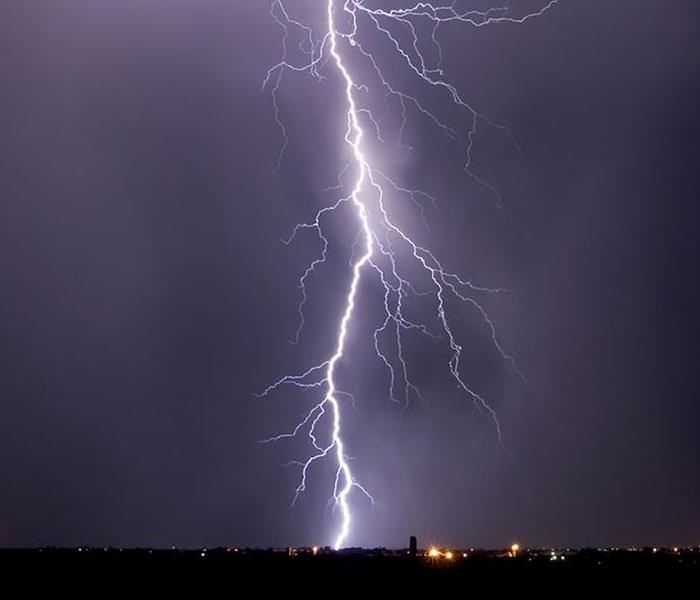Archived Storm Damage Blog Posts
Aftereffects of Storm Water Damage
9/27/2022 (Permalink)
 Mold growth is common occurrence following water damage from storms.
Mold growth is common occurrence following water damage from storms.
A Menacing Mix
Moisture, heat, and nutrients (nearly anything organic), can quickly result in a mold explosion following storm water damage. The longer these conditions remain and mold is allowed to grow, the greater the risk and more difficult the cleanup. Signs of mold contamination include:
- Musty, earthy, foul odors.
- Discolored ceilings, walls, or other surfaces.
Time is of The Essence
Flood damaged homes require special attention for safe and effective mold removal. It takes as little as two or three days for mold to grow, with colonies spreading easily throughout your home via spores in the air. Speedy removal is essential for success. As soon as it is safe to return to your home, don’t delay the cleanup and drying process!
You are Not Alone
The professional mold removal specialists at SERVPRO of Streamwood, Bartlett, West Chicago and Warrenville have the technology, tools, and training to address your mold removal needs quickly and effectively, eliminating the probability of overlooked or improperly removed mold colonies that could result from DIY removal techniques that could lead to unnecessary health issues, inconvenience, damage and expenses.
Prepare Your Home for Hurricane Season
9/27/2022 (Permalink)
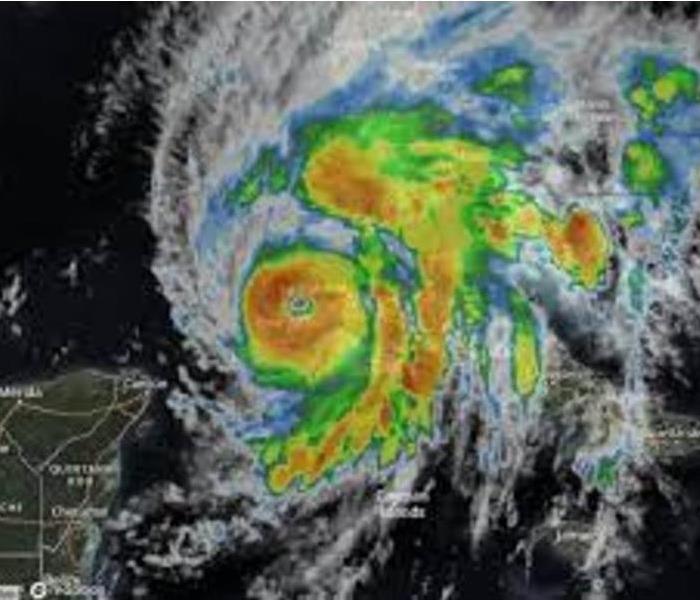 Know the hurricane season tips to adequately prepare your family and home for the upcoming weather.
Know the hurricane season tips to adequately prepare your family and home for the upcoming weather.
Hurricanes can produce dangerous conditions:
- Winds in excess of 155 mph
- Tornadoes and microbursts
- Flying debris
- Heavy rainfall
- Storm surges
- Floods
- Mudslides
- and more…
Don't wait until a hurricane comes your way. Prepare ahead of time with these hurricane season tips:
- Keep supplies handy.
Dedicate storage for a three-day supply of water, dried or canned foods, and other essentials. Not sure what you need? Consult FEMA’s emergency supply list. Having the right supplies is among the top hurricane season tips. - Unplug electronics – even if you have a surge protector.
This is the best protection against surge-related damage. - Check for leaks.
Check doors, windows, and walls, such as areas where cables and pipes enter, for openings that could allow water to penetrate. - Prepare for long-term outages.
Consider purchasing a generator. It doesn’t have to be the pricey, whole-house version. Even one that’s big enough to run a refrigerator and plug in a few essentials can really make life easier. Consider what you can’t live without if you were to be without electricity for a few days – such as a sump pump or well pump – and select a model that best fits your needs. - Trim trees and shrubbery.
Trim back any branches touching your home. If they rub your roof, they could pull parts of it off in a storm. Keep trees well pruned to allow wind to pass through with minimal damage and debris. Consider regrading around trees to strengthen the ground and give roots something to cling to. - Clean gutters.
This could prevent potential roof damage and flooding inside your home. - Clear clutter.
Prevent items from flying off to Oz. Get rid of items you are no longer using, which can turn into projectiles. Bring lightweight outdoor items such as patio furniture, plants, toys, and trash cans inside. - Secure your home.
Highly recommended are window shutters (not the pretty ones – the ones that protect your glass), roof clips (to hold your roof on – it is NOT too heavy to fly away), and garage door braces (to keep your garage door from blowing away). Anchor fuel tanks as well. Ensure all items are professionally installed. - Verify insurance coverage.
Avoid the wind and water debate. Check your homeowner’s policy and purchase additional flood insurance through the National Flood Insurance Program to ensure you have adequate protection if necessary.
Do you have a plan?
You and your family should know - in advance - where to go when a storm comes. Make a plan now, including a safe evacuation route inland, the location of official shelters, and a safe off-site place to meet in the event you are separated. Don’t forget necessary medications and emergency plans for pets as well! Heed these hurricane season tips and evacuate if you live in a the following high risk homes:
- Mobile or manufactured home
- On a coastline or offshore island
- Near a river or flood plain
- In a high-rise
Tornado Warning Systems
9/20/2022 (Permalink)
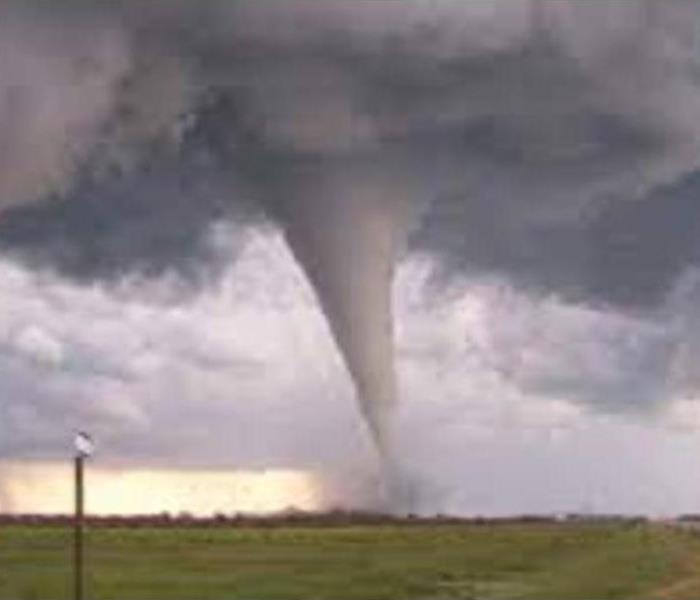 Tornadoes are among the deadliest forces found in nature.
Tornadoes are among the deadliest forces found in nature.
History of Tornado Warning Systems
In the late 1800s, the US army started studying the science behind tornadoes and how to predict them. However, they decided it wasn’t wise to issue public warnings for fear of causing panic and chaos. Even mention of the word “tornado” was banned.
This thinking changed in 1948 when a tornado tore through Oklahoma’s Tinker Air Force base, causing millions of dollars worth of damage and killing several people. By this point, large outdoor sirens were already being used in Europe to warn civilians of air strikes during World War II. The concept came to America in 1950 when President Harry Truman responded to the threat of the Cold War by setting up sirens to warn of an atomic attack that never came.
In 1970, there were many functional sirens still in place – government officials began using sirens as a tornado warning system. Many of these sirens are still in place, but sometimes power loss and other issues prevent them from working when they’re needed most.
That’s why newer technology – from TV to radio to text messaging – is used today to warn the public of approaching tornadoes. Utilizing multiple systems increases the chance that every citizen will hear about the storm and seek shelter.
How to Stay Informed of Severe Weather
Whether you live in Tornado Alley and have sirens in your town, or you live in a lower-risk state, follow these tips so you never miss the latest tornado warning:
Keep your cell phone on you
As long as your cell phone has a signal, you can receive a warning message from the Wireless Emergency Alert system. When a tornado warning is issued in a particular county, every cell tower in the area transmits a warning to all phones within range.
The incoming alert has a different sound than just a normal text message or ringtone to catch your attention. The alert also has a text message attached with a brief explanation of the warning and advice to take shelter immediately.
Storm alerts don’t work with older phones, so contact your wireless provider to make sure your cell is compatible. If not, consider upgrading. No fee is required to participate in and receive storm alerts.
Turn on the news or the radio
If you look outside and notice dark, swirling clouds, tune in to your local news station (on TV or the radio) for an update. If a bad storm is coming, normal coverage should be replaced by emergency storm updates and tornado warnings.
Roof Damage After a Storm
9/19/2022 (Permalink)
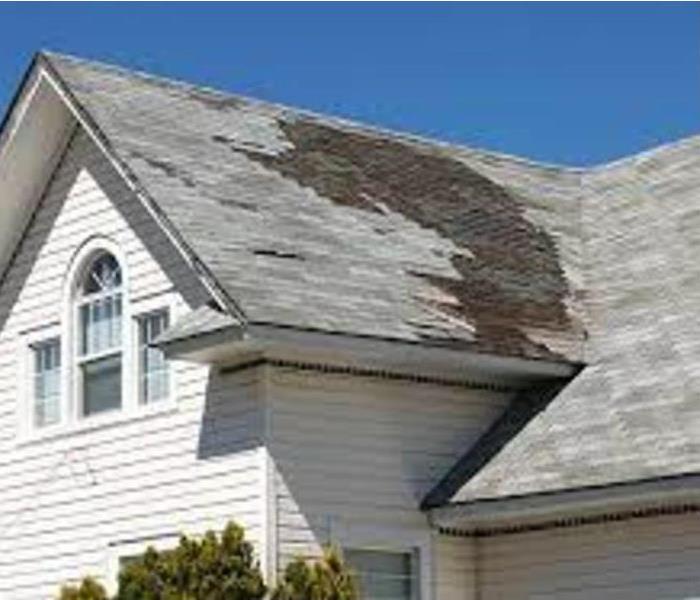 After a storm, your first instinct may be to check your house for wind or hail damage, climbing up on the roof can be dangerous.
After a storm, your first instinct may be to check your house for wind or hail damage, climbing up on the roof can be dangerous.
Indoor Inspections
Performing an indoor, room-by-room inspection after a storm is not only safer than getting on the roof but can detect many signs of roof damage or water leaks without having to climb a ladder. Start your inspection on the side of the house that received the brunt of the storm’s intensity—which is usually in the direction from where the storm approached—and work your way across the house. Check in the corners and around the bases of light fixtures and ceiling fans for signs of moisture. If the sun is shining, go up into the attic and look for sunlight passing through the plywood. If you see light, this may indicate damage to your roof’s deck, which could cause leaking and water damage. While up in the attic, use a flashlight to look for dark stains in the corners or streaks along the inclined edges. These marks could be caused by leaks coming from damaged areas or through the ventilation.
Outdoor Inspection
Even though it’s not safe to climb up on the roof, there are still several ways you can safely look for storm damage from the outside.
Walk around the house to see if any shingles or other roof materials are on the ground.
Look for tree limbs or other storm debris on the roof.
Do a visual inspection of the roof from the ground with your eyes, binoculars, or even a camera drone.
Does the flashing on your chimney or vents look bent or detached?
Do you see any missing, curled, or cracked shingles?
Are there any dark patches caused by granule fallout?
If you do see damage, call in the professionals at SERVPRO of Streamwood, Bartlett, West Chicago And Warrenville as soon as you can.
Other Dangers to Avoid
Using a ladder or walking around on your roof aren’t the only dangers you should avoid after a storm. To make sure you stay safe, keep away for these situations.
Don’t walk or drive through standing water. Not only could it be contaminated with harmful bacteria, but it might also be hiding debris or sinkholes.
Don’t touch downed power lines. Call the fire department or the utility company to deal with them.
Don’t clear debris without protective clothing. It could be riddled with rusty nails, broken glass, or other things that can be hazardous to your health.
Don’t climb trees to remove broken limbs—this could be even more dangerous than getting on the roof!
How To Know It’s Time To Call A Storm Damage Restoration Company
4/5/2022 (Permalink)
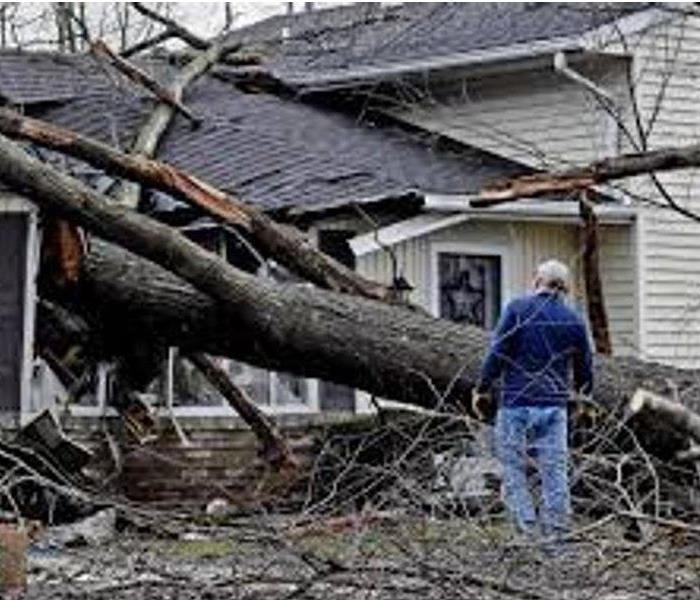 Storms can happen in a flash. Let SERVPRO of Streamwood, Bartlett, West Chicago, and Warrenville help when storm damage is severe.
Storms can happen in a flash. Let SERVPRO of Streamwood, Bartlett, West Chicago, and Warrenville help when storm damage is severe.
The weather conditions in Illinois can easily result in storms. As a result, your home or property may receive damage. One example of damage after stormy weather is roof damage. This may result in roof leaks and further damage.
Here are some signs that you should call SERVPRO of Streamwood, Bartlett, West Chicago, and Warrenville.
1. Wind damage
Winds that accompany a storm can be devastating. This type of damage is what you should first look for after a storm. Here are some signs of wind damage to let you know that it is time to call.
- Missing shingles: Missing shingles is one obvious sign of wind damage. Already peeling or cracked shingles are even more susceptible. New and well-maintained roofs are less at-risk. Some roofing manufacturers also have warranties that cover severe wind damage.
- Visible loss of granules: Commonly, brand new roofs suffer some granule loss. The loss of granules is found in characteristic horizontal lines with storm damage. This is a sign of a broken shingle seal. As shingles flap in the wind, granules rub off.
- Visible water infiltration: Leaks that penetrate through the ceilings are obvious signs of wind damage. This is true if you see a water stain on your ceiling. If this happens, it means that both the roof underlayment and shingles are compromised.
- Loose debris: Loose debris after a storm can also be an indication of wind damage. If your roof is struck by elements because of the high winds, you will likely find debris in and around your home. Ensure that you clear all debris to reduce the safety risk.
2. Snow and hail damage
Hail forms at the same range of temperature at which snow is possible. Hail consists of compact-sized balls of ice. They are capable of denting or punching through solid objects when they fall at full force. Here are some signs of hail and snow to let you know that the service of a storm damage restoration company is needed:
- Damaged or missing shingles: Hail can cause the immediate loss of shingles even if they were intact before a storm. Look for dents and cracks to find the location of the impact. The shingles may need replacement because of the damage, even if they are still present.
- Broken or clogged gutters: Clogged gutters should be cleaned immediately after a storm. This is to allow water to drain properly away from the foot of the building. If it does not, the foundation of your house can get eroded, making the structure unsafe. Ensure that all downspouts and gutters are not broken or clogged. If they are, call a restoration company.
- Ice dams: Shingles become vulnerable to ice dams when not properly maintained. Ice dams form due to the freezing of melted snow on the eaves of your roof. Ice dams can prevent the proper flow of water off your roof, encouraging leaks. An ice dam is an issue you can easily notice.
3. Water damage
Water damage is unlike wind and hail damage. Sometimes, it takes a while before water damage gets noticed. However, it can still lead to serious damage to your health and home if not addressed. You should call a storm damage restoration company if you notice any of these signs:
- Damage to roof accents or supports: Damage to the supporting structures of your home may not be obvious. Your shingles may also appear to be intact. However, ensure that you look for areas where there is heavy pooling of water after or during heavy rain. You should also check the chimney, flashing around vent pipes and other areas susceptible to pooling of water.
- Visible attic issue: The attic of your house is part of your home’s ecosystem. A sign of leaks you can see in your attic is moisture penetration. You may need to replace the insulation and inundated surfaces to prevent the growth of mildew and mold.
- Odd smell: You may not notice water even if there is a minor leak somewhere in the wall of your home. However, you may notice some type of smell. You will notice more serious signs of water damage if you can locate the source of the smell.
- Discoloration on the walls: Whenever there is water damage, and it is not visible, there is a high chance that the problem is going into the walls of your home. You may not easily notice dripping water as a result of small leaks. However, you will start noticing discoloration on your walls as time goes on. It is a sign of excess moisture in your home.
- Warped flooring: Warped flooring is another sign that there is unseen water in your home. The result of water getting between the floorboards is buckling and uneven flooring. To be sure of this, ensure that you check your baseboards. There could also be mold beneath them.
Steps to Take Immediately After a Storm Damage
4/5/2022 (Permalink)
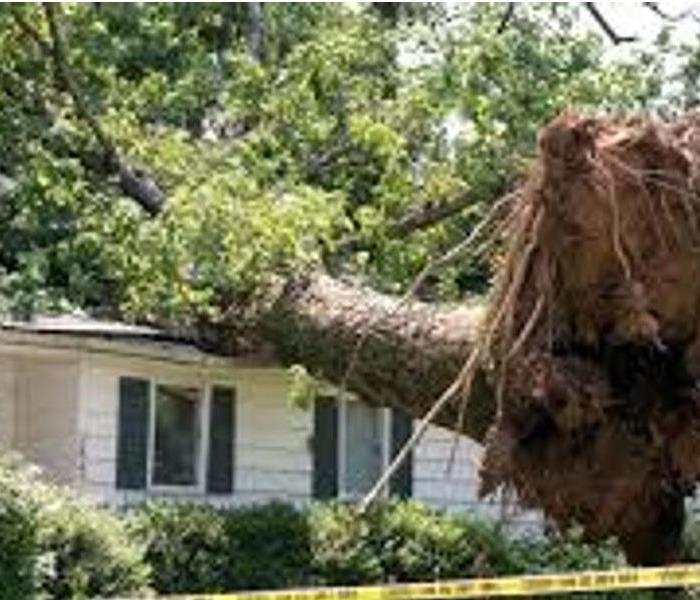 Some post-storm damage can create safety and health hazards as well, so having a strategy to deal with damage will help you to be ready to take steps
Some post-storm damage can create safety and health hazards as well, so having a strategy to deal with damage will help you to be ready to take steps
Storm damage can occur at any time and can cause an immense amount of harm to your home. Heavy rains can cause flooding and powerful winds can cause roof damage and downed trees on your property. Some post-storm damage can create safety and health hazards as well, so having a strategy to deal with damage will help you to be ready to take steps immediately after the storm.
Take Safety Precautions
Heavy winds and rain can create physical hazards such as collapsed roofing materials, window damage, collapsed walls or standing water in the basement or home interior. In addition, moisture can soak into furniture, carpeting, and building materials making the perfect environment for mold growth that can cause health issues. Shut off the main gas line if you smell gas. Beware of broken glass, exposed nails, and other sharp objects on the property. Contact SERVPRO of Streamwood, Bartlett, West Chicago & Warrenville to help do basic tasks to secure your property and make it safe to use. If necessary, arrange for an alternative place for you and your family to live while your property is being restored to safe living condition.
Photograph the Damage
If it is safe to move around your property, use your cellphone or a camera to photograph the damage so that you will have a record for your insurance company. This action will ensure that you are fully compensated.
Contact Your Insurance Company
Contact your insurance agent to notify them about the damage to your home immediately. The company will send out an adjustor to determine the extent of the damage so that payment for repairs can be made.
4 Main Causes Of Roof Storm Damage
4/5/2022 (Permalink)
 After a storm there are 4 main reasons your home could be damaged.
After a storm there are 4 main reasons your home could be damaged.
Here are four main suspects of storm damage to your roof: wind, water, hail, and debris.
Wind Damage
During thunderstorms, wind gusts can be gale-force (40-60mph) or even hurricane force (75+ mph) which can cause severe damage to your roof’s shingles. A wind that speed can easily tear off shingles or just lift and curl them, both revealing the protective underlayment beneath your shingles. When that underlayment is exposed, your roof is immediately at risk of leaks as water can leak underneath the nearby shingles and seep into your home.
Water Damage
There are a couple of ways extensive rainfall can cause pooling and water damage after the storm settles down. First, if your roof does not have proper drainage or has previously weakened spots, that heavy rainfall will simply sit on your roof and cause sunken spots or leak through any damaged shingles very easily. Also, if you have clogged gutters, that rainwater cannot run off the roof properly and will pool at your gutters which can lead to it seeping into those weak spots at the edge of your roof.
Hail Damage
Hail large enough to damage your roof is not super common, but it can happen. And even small hail paired with strong gale winds can be enough to throw that hail into your shingles hard enough to dent them and slough off those vital granules that are the first protective layer of your shingles. Hail can also crack and peel up the edges of your shingles.
Damage From Debris
During severe thunderstorms, all kinds of debris like sticks and branches can snap off and blow onto your roof. If you’re especially unlucky, you could have an overhanging tree branch or tree fall on your roof, causing catastrophic damage. But even the small branches, twigs, and other trash debris that flies around and lands on your roof can cause damage. Imagine a gale-force wind carrying with it large branches headed straight for your roof.
Is The Exterior Of Your Home Ready For The Fall Weather?
10/6/2021 (Permalink)
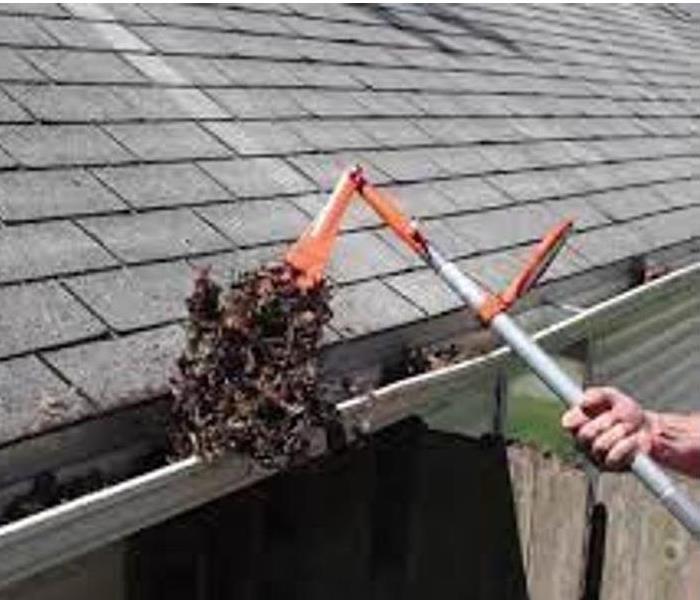 If the exterior of your home is damaged, it can cause interior problems to occur.
If the exterior of your home is damaged, it can cause interior problems to occur.
The exterior of your home is what protects you from the outdoor elements. It keeps you warm and dry from the sleet, snow, and rain. If the exterior of your home is damaged, it can cause interior problems to occur. Before Fall arrives, it is a good idea to check for any problems. You should check the interior and exterior of your property with the change of each season.
Roof and Gutter Checks
Your roof is one of the most vital areas to check. If you have a missing or broken shingle, you risk water damages to the interior of your home. You also should check that the structure of your roof is in good shape, as sleet and snow can become heavy, which could cause more damages. If your roof looks damaged, have it repaired as soon as possible. Your gutters should be cleaned of all debris. Debris in your gutters can cause water damages and even ice dams to occur.
Pipe Checks
If you have unprotected pipes on your property, it is important that they are protected. Colder weather can weaken pipes, causing them to splinter and burst. You may also end up with frozen pipe lines. Both problems can cause water damages and possible mold growth.
Window and Siding Checks
Always check that your windows are sealed and in good shape. You never want ice, rain, snow, or cold air to enter through cracks in your window. If you have damages to your siding, it could result in water damages to the interior of your home. Repair any damages to ensure you do not have water damages this Fall.
Tree Checks
If you have dead branches or trees, now is the time to remove them from your property. A severe storm can cause dead trees to fall, which could result in damages to your home and property. If you have low limbs above your roof, have them trimmed. You never want a heavy limb to fall and damage your roof.
If you do have water damages to your property, contact SERVPRO of Streamwood, Bartlett, West Chicago, & Warrenville immediately. Water damages are an emergency and can quickly cause lasting damages to your home.
Types of Damaging Winds
9/30/2021 (Permalink)
 There are different types of damaging winds that can affect properties and surrounding trees
There are different types of damaging winds that can affect properties and surrounding trees
Straight-line wind is a term used to define any thunderstorm wind that is not associated with rotation, and is used mainly to differentiate from tornadic winds.
A downdraft is a small-scale column of air that rapidly sinks toward the ground.
A macroburst is an outward burst of strong winds at or near the surface with horizontal dimensions larger than 4 km (2.5 mi) and occurs when a strong downdraft reaches the surface. To visualize this process, imagine the way water comes out of a faucet and hits the bottom of a sink. The column of water is the downdraft and the outward spray at the bottom of the sink is the macroburst. Macroburst winds may begin over a smaller area and then spread out over a wider area, sometimes producing damage similar to a tornado. Although usually associated with thunderstorms, macrobursts can occur with showers too weak to produce thunder.
A macroburst is an outward burst of strong winds at or near the surface with horizontal dimensions larger than 4 km (2.5 mi) and occurs when a strong downdraft reaches the surface. These trees were felled by straight-line winds in Minnesota in 2011.
A microburst is a small concentrated downburst that produces an outward burst of strong winds at or near the surface. Microbursts are small — less than 4 km across — and short-lived, lasting only five to 10 minutes, with maximum windspeeds sometimes exceeding 100 mph. There are two kinds of microbursts: wet and dry. A wet microburst is accompanied by heavy precipitation at the surface. Dry microbursts, common in places like the high plains and the intermountain west, occur with little or no precipitation reaching the ground.
A microburst is a small concentrated downburst that produces an outward burst of strong winds at the surface. Microbursts are generally small and short-lived.
A downburst is the general term used to broadly describe macro and microbursts. Downburst is the general term for all localized strong wind events that are caused by a strong downdraft within a thunderstorm, while microburst simply refers to an especially small downburst that is less than 4 km across.
A gust front is the leading edge of rain-cooled air that clashes with warmer thunderstorm inflow. Gust fronts are characterized by a wind shift, temperature drop, and gusty winds out ahead of a thunderstorm. Sometimes the winds push up air above them, forming a shelf cloud or detached roll cloud.
A derecho is a widespread, long-lived wind storm that is associated with a band of rapidly moving showers or thunderstorms. A typical derecho consists of numerous microbursts, downbursts, and downburst clusters. By definition, if the wind damage swath extends more than 240 miles (about 400 kilometers) and includes wind gusts of at least 58 mph (93 km/h) or greater along most of its length, then the event may be classified as a derecho.
A haboob is a wall of dust that is pushed out along the ground from a thunderstorm downdraft at high speeds.
Lightning: Different types, how to stay safe
9/29/2021 (Permalink)
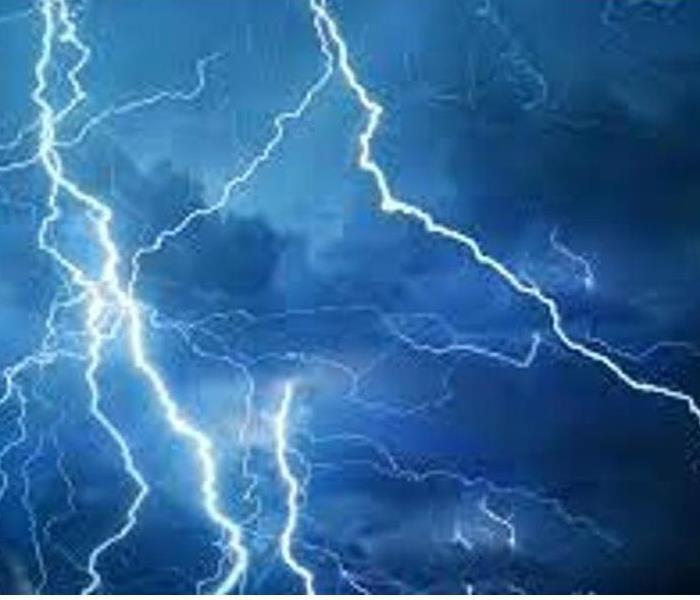 There are three common types of lightning: cloud to ground, cloud to cloud and cloud to air.
There are three common types of lightning: cloud to ground, cloud to cloud and cloud to air.
WHAT IS LIGHTNING?
Lightning is a natural discharge where different areas of the atmosphere equalize in charge. This causes insane quick energy known as lightning which can be extremely dangerous. Thunder follows lightning as thunder is created from a shock-wave in lightning.
There are three common types of lightning: cloud to ground, cloud to cloud and cloud to air.
CLOUD TO GROUND LIGHTNING - NEGATIVE CHARGECloud to ground lightning is the most dangerous. The ground is mainly consisted of positively charged particles while the bottom of violent storm clouds have negative charged particles. Opposites attract in this situation, and lightning goes after positively charged particles. The most common cloud to ground lightning strike is a negatively charged strike.
CLOUD TO GROUND LIGHTNING - POSITIVE CHARGE
There are situations where lightning finds negatively charged particles on the ground level and positive charges in the upper portion of a cloud overcome negative charges in the bottom of a cloud. This is when a positive lightning strike happens. Positive lightning strikes are not as common but are more dangerous. They have to travel farther distances which mean they also are stronger. They also pack louder thunder to follow.
CLOUD TO CLOUD LIGHTNINGCloud to cloud lightning happens when a negatively charged cloud finds a positively charged cloud and opposites attract. These do not strike the ground obviously. They just travel from cloud to cloud.
CLOUD TO AIR LIGHTNING
Cloud to air lightning happens when negative charged air particles become attracted to positive charges within a cloud. These produce some loud boomers but do not hit the ground!
RISKS WITH LIGHTNINGIt is estimated that there are about 50 deaths per year due to lightning in the United States. Risky activities involved with lightning include camping, sailing, swimming, and golfing. Lightning searches for the highest structures but that might be you if you are in an open area. Also, if lightning hits open water and you are in the open water, you will likely get electrocuted as a charge carries through water.
HOW TO STAY SAFE
The best thing you can do when you hear thunder is to go indoors. When thunder roars go indoors! Do not take shelter under a tree. If lightning hits the said tree, it could still electrocute you. Take shelter if you can and if you can’t, stay as low to the ground as possible until 30 minutes after you hear the last boom of thunder.
Be Prepared for a Flash Flood
9/29/2021 (Permalink)
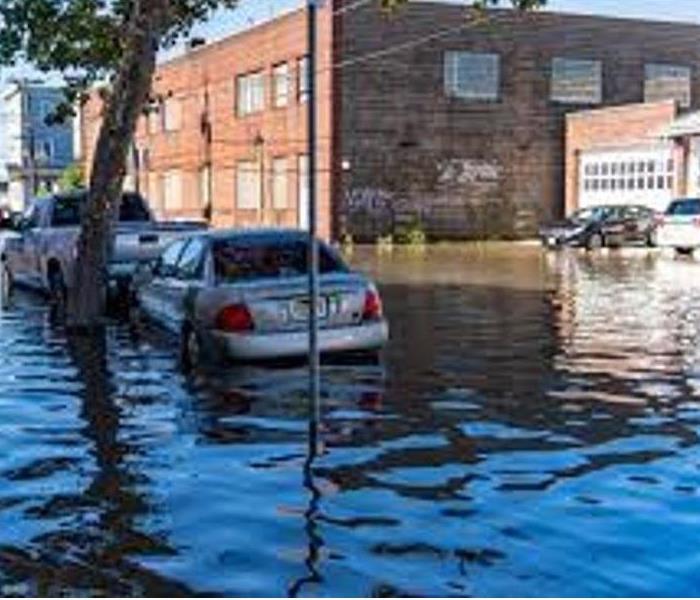 Floods are among the most common and devastating types of natural disasters.
Floods are among the most common and devastating types of natural disasters.
Floods are among the most common and devastating types of natural disasters. They can happen in a wide variety of places and no two floods are exactly the same. Some happen gradually, during a long period of snow-melt or rain. Others, like flash floods, can occur extremely fast, seemingly without warning. Small creeks or dry stream beds can instantly overflow with water, acting as conduits for large floods. Although nearly everyone should prepare for floods, no matter where you live, it is especially important to be prepared if you live near water, dams, or in a low-lying areas.
Here are some tips to help you prepare for a flood:
- Use check valves to keep floodwater from flowing backward into your home’s drains.
- If you live in a high flood-risk area, elevate your furnace, electric panel, and water heater.
- Consider getting flood insurance, since property insurance generally does not cover damage from floods.
- Have water barriers prepared that you can deploy around your home to keep water from entering it.
- Prepare a home emergency supply kit, including an emergency radio so you can get updates from authorities.
- Use waterproofing compounds to seal your basement walls. Even if your house does not flood, the possibility exists that the ground around your house could become saturated, and this groundwater will likely attempt to enter your basement. Install a reliable battery back up sump pump or water powered sump pump to help keep your basement dry.
Be prepared to evacuate:
In the event of evacuation, how will you leave?
- Consider where you would go – family or friends’ houses in different towns, hotels, or public shelters. Learn multiple ways of getting to these places.
- Have your family agree on places to meet in the event of an emergency. Chose a place in your neighborhood and another outside of it.
- Plan on how to take care of pets in an emergency situation – you can take them with you, but plan ahead, since they may not be allowed in emergency shelters.
- When you leave, lock your house, and bring your emergency kit. .
- As you evacuate, watch out for floodwater. If possible, avoid the water, since it could contain contaminants or the risk of electric shock from downed power lines. In general, stay away from damaged power lines to avoid risk of electrocution. If you encounter moving water, avoid walking through it if you can – moving water can be much more powerful than it appears.
- Don’t return home until the authorities have declared that it is safe, even if the flooding has receded, since roads and buildings could be damaged and drinking water unsafe. As a general rule – remain extra cautious even after the flood water has dissipated.
- Stay informed as much as you can, via TV, radio, internet, or weather radio. Keep in mind that authorities may not necessarily provide continuous updates, but it is still a good idea to check regularly for information and instructions.
Watch vs. Warning: What's the Difference
9/22/2021 (Permalink)
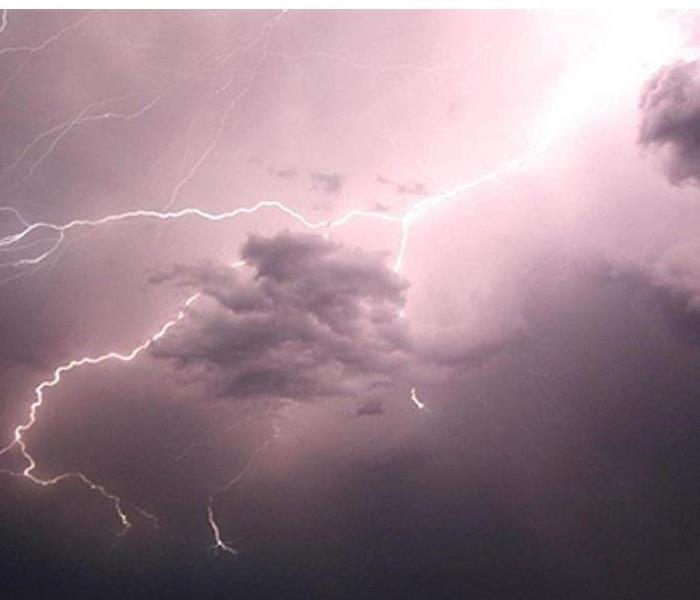 The differences between a tornado and severe thunderstorm watches and warnings.
The differences between a tornado and severe thunderstorm watches and warnings.
With the severe weather season underway, now is a great time to go over the differences between a tornado and severe thunderstorm watches and warnings.
A WATCH means that the potential exists for the development of severe thunderstorms or tornadoes, depending upon the specific type of watch issued.
- In a Tornado Watch, this DOES NOT mean a tornado has been seen or even indicated by radar...it just means that conditions are favorable for the formation of tornadoes in thunderstorms.
- A Severe Thunderstorm Watch means that conditions are just conducive for the development of severe weather, and DOES NOT indicate that severe weather has been reported. While no immediate action on the part of the general public is required for the issuance of a watch, citizens should keep up to date on the current weather situation and be prepared to seek shelter if necessary.
A WARNING, on the other hand, requires more immediate action and should be taken seriously.
- A Severe Thunderstorm Warning indicates that severe weather is imminent in your area or is already occurring (based on either human observation or doppler radar). The term severe refers to hail greater than or equal to 1.00" in diameter and/or wind gusts that meet or exceed 58 mph. Although these storms can also be associated with dangerous cloud-to-ground lightning or heavy rainfall that is capable of causing flash flooding, neither of these two items serve as criteria for a severe thunderstorm warning being issued.
- A Tornado Warning can be thought of as a very specific severe thunderstorm warning, and means that a tornado has been either spotted by a human observer or indicated by a doppler radar. Similar to a severe thunderstorm warning, once a tornado warning is issued for your area, you should take cover immediately...as the likelihood of you being directly impacted by a tornado is at a heightened risk.
With this new profound knowledge, you'll be better prepared the next time severe weather threatens your area. But sometimes, watches and warnings are not enough to fit the specific needs of businesses and companies.
Hail: Tips to prevent injury, reduce damage
4/6/2021 (Permalink)
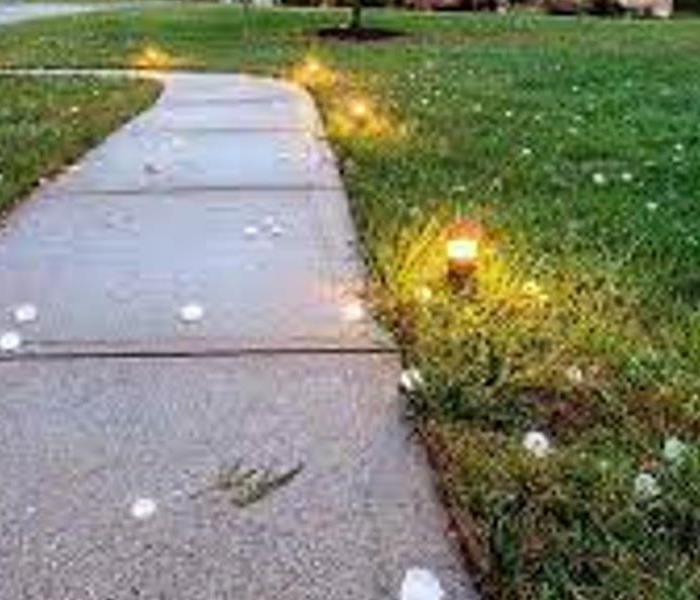 General tips to reduce damage and prevent injury:
General tips to reduce damage and prevent injury:
There are about 5,600 hailstorms in the United States every year, based on National Oceanic and Atmospheric Administration data. Learning about this weather phenomenon and how to properly prepare for it can save lives and minimize damage.
HAIL CHARACTERISTICS
Hail forms when raindrops hit very cold temperatures and freeze into balls of ice. Depending on the size, hail can be extremely damaging to people, animals, property, and cars. And, if winds are strong enough, hail can fall with enough force to penetrate solid surfaces. Falling in paths known as hail swaths, hail storms can range in size from a few acres to an area 10 miles wide and 100 miles long. Some geographies are more susceptible to hailstorms because the elevations at which they form are much closer to the ground than for locations at or near sea level, where hail has time to melt before reaching the ground. This is historically the case in the high plains, but no area is immune from the risk of hailstorms.
PREPARING FOR HAIL
The first concern when preparing for a possible hail storm is life safety. After that, thoughts can turn to protect physical property. Much of the preparation for hail events resides in roofing systems, maintenance, and upkeep. With that in mind, consider taking action to protect lives and reduce property damage.
General tips to reduce damage and prevent injury:
- Stay indoors and make sure all window covers are intact in case of window breakage.
- Do not inspect property damage until the storm has passed. Hail damage may not be obvious so it’s important to examine all glass surfaces, building walls, and the roof.
- Check HVAC equipment. Hail often damages condensing coils by denting the exchange fins.
- Consider storing your fleet vehicles in more than one location to spread risk and explore the possibility of protected coverings or indoor garaging.
Roof-specific information that may reduce damage:
In terms of roof susceptibility and maintenance, the type and age of the roofing system, as well as its exposure to elements, play a role in how it performs against hail.
- Concrete or clay tiles perform better in hailstorms than asphalt or wood shingles.
- Built-up roofs with denser substrates and multiple base sheets perform better than those using lighter substrates or organic felts.
- Coarse aggregate surfacing, such as ballast or gravel materials, increases the hail resistance of a roof.
- Regular inspection and maintenance of roofing systems will increase the life and resistance to hail and wind events.
HVAC-specific tips, examples, and factors that may reduce damage:
Hailstorms can be hazardous to any and all rooftop equipment – but none more than HVAC units, condensers, and refrigeration units. Damage to these vulnerable systems can affect heating and cooling, cause water damage and result in loss of facility use.
Stay Safe In A Severe Thunderstorm
4/6/2021 (Permalink)
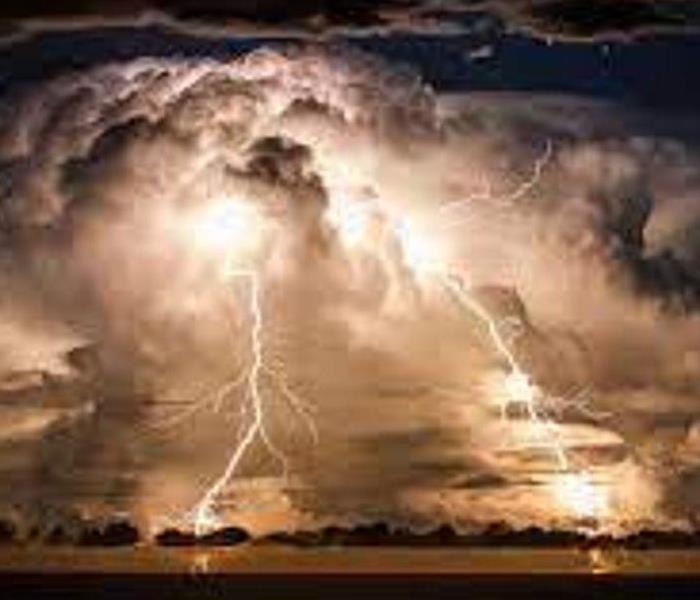 Tips to Stay Safe During A Thunderstorm
Tips to Stay Safe During A Thunderstorm
Watch The Weather Forecast
- Know the difference between a thunderstorm watch and a thunderstorm warning. A watch simply means conditions could lead to the development of a storm. A warning means a thunderstorm has already developed and been spotted nearby.
- If you’ve just moved and are new to an area, learn the name of your county and surrounding ones, as well as cities and landmarks close by. The National Weather Service usually issues thunderstorm warnings by county, so this will help you understand if your home or workplace is in danger.
- Get a battery-powered or hand-crank weather radio, so you can receive updates even if the power goes out.
Prep Your Home Before A Thunderstorm
- With the spring thunderstorm season approaching, now’s a good time to go out and cut down any loose or rotting branches that could fall on your home during a strong wind.
- If a thunderstorm is headed your way, bring in any outdoor furniture that could be blown around or damaged by hail, close and shutter windows (or close blinds and drapes), and unplug appliances and computers to protect them from power surges that could be caused by lightning.
- Charge all phone and electronic devices ahead of the thunderstorm in case the power goes out. Move computers and electronic devices off of the floor to avoid water damage if it floods.
- Turn off circuit breakers to avoid power surges.
- If you plan to use a portable generator, make sure it’s installed by a qualified electrician. NEVER operate a portable generator inside your home or garage.
- Bring pets inside if you can
During The Thunderstorm
- Go inside and stay there, away from windows and doors. Avoid using corded phones (wireless handheld devices are ok, says the National Weather Service) and doing the dishes or laundry, since lightning can travel through metal plumbing fixtures.
- In severe thunderstorms with high winds or a tornado risk, head to a windowless interior room or the basement, but don’t lean against concrete walls or lie on concrete floors. Most are reinforced by metal bars or webbing, notes the CDC, and lightning could travel through the metal and injure you.
After The Thunderstorm
- Stay inside at least 30 minutes after you last hear thunder to be sure the storm has passed.
- Heavy rains during thunderstorms can flood low-lying areas, so don’t drive over flooded roadways or through puddles when you aren’t sure of their depth.
- Watch out for downed power lines, fallen branches, and other potentially dangerous debris, and keep pets on a leash to help them avoid these hazards, too. Never touch a person or object (fences, tree limbs, water, etc.) that has come into contact (directly or indirectly) with a downed power line, but call 911 immediately.
- Have a qualified electrician inspect any water-damaged electrical equipment, systems, or electronics.
- Do not touch a circuit breaker or replace a fuse with wet hands or while standing on a wet surface.
- If you smell gas, notify emergency authorities immediately. Do not turn on lights, light matches, use electrical equipment, or do anything that has the potential to create a spark.
Ways to Prevent Storm Damage to Your Home
4/6/2021 (Permalink)
 Prevent Storm Damage to Your Home
Prevent Storm Damage to Your Home
In any season, storms can be severe. There are ways to prepare your home for the inevitable storms that sooner or later come, however. Here are some steps you can take to minimize the risk of damage to your home when severe weather strikes. In some cases, taking these steps can mean the difference between costly home repairs and no storm damage to your home at all.
1. Remove Dead Wood.
Trimming your trees regularly will help fewer branches fall in heavy wind or other severe weather. For particularly tall trees, experts can do the trimming for you and can also tell you when trees are at risk of being blown over in a storm so they can be removed.
2. Secure Outdoor Items.
Loose items like grills, picnic tables, and lawn furniture should be brought inside to avoid becoming projectiles in storms with high winds. Decorations, even when they are securely attached to the home, could also cause damage or be destroyed in the storm.
3. Deal with Drainage Problems.
Having the gutters cleaned once leaves have fallen should be a given, but there can be other drainage problems around your home, including areas where water can drain onto the foundation and damage it. Landscaping professionals can help you identify the problems and find solutions so that you don’t have any issues when the storms come.
A little home maintenance can prevent storm damage.
4. Inspect the Roof Periodically.
A brand new roof should withstand the most severe weather, but if your roof is 5-10 years old or older, it should be checked for loose shingles, nails, and sheathing. Not only can shingles blow off in a storm, but loose nails and sheathing can cause chunks of roofing to be dislodged or create openings for rain and ice to penetrate.
If an inspection does turn up any possible leaks, getting them fixed right away will protect your home from damage in severe weather. Roofs that are over 15 years old risk sudden deterioration or failure in storm situations even if no problems are apparent.
5. Consider Impact-Rated Windows.
You may be able to protect your windows from damage by installing hurricane shutters, or just boarding up the windows if a severe storm is imminent. The fact is, though, that any new windows are likely to be more airtight and impervious to leaks and damage than older windows.
How to Prepare for a Snowstorm
10/7/2020 (Permalink)
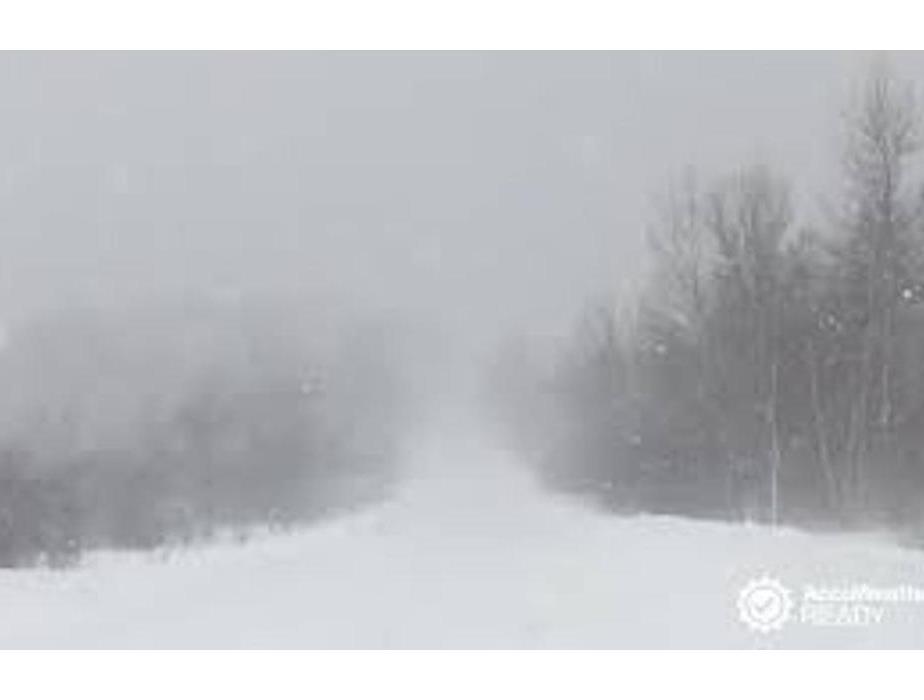 Be prepared when old man winter comes
Be prepared when old man winter comes
Before
Before a snowstorm, stock up on essentials and be prepared to be confined to your home for an extended period of time. It’s important to put your winter storm plan to use in advance to avoid a last-minute dash to an empty grocery store.
- Create an emergency kit containing non-perishable food and water that will last you a few days. Also include a flashlight, battery-operated radio, and extra batteries. Don’t forget any medications or other personal necessities either you or your family members may need.
- Subscribe to your local weather warning system.
- Keep the cold air out by weather-stripping your doors and windows.
- Fill your gas tank, keep blankets, and some emergency supplies in your car.
- Gather extra coats, gloves, hats, and other warm clothes for your entire household.
- Communicate with all of your family members about what to expect during a snowstorm.
During
Stay out of harm’s way and pay attention to snowstorm updates on your radio. Try not to wander outdoors until the storm warning is lifted.
- Avoid driving or walking outside. Stay indoors if possible.
- Pay attention to storm updates.
- Check on neighbors. The elderly and young children may need extra help during severe weather.
- Allow pets easy access to food, water, and warmth. Setting up extra pet beds, blankets or even dressing them in boots and sweaters may be a good idea.
- Make sure you set up generators correctly and limit their use to essential appliances.
- Keep a close eye on space heaters. They use a lot of power and are highly flammable.
- Learn the symptoms of frostbite and hypothermia. Take steps to prevent cold weather-related injuries by drinking plenty of water, taking breaks indoors, and staying active when you are outside.
After
Even though the snow has stopped falling, icy roads or melting snow can still be hazardous.
- Use caution when venturing outside for the first time.
- Use sand or ice melt on sidewalks and driveways.
- Avoid driving until road conditions improve.
- If you decide to shovel snow, do so with care. It’s easy to overexert yourself with a task you’re not used to.
WHEN DO I NEED EMERGENCY TARPING?
10/6/2020 (Permalink)
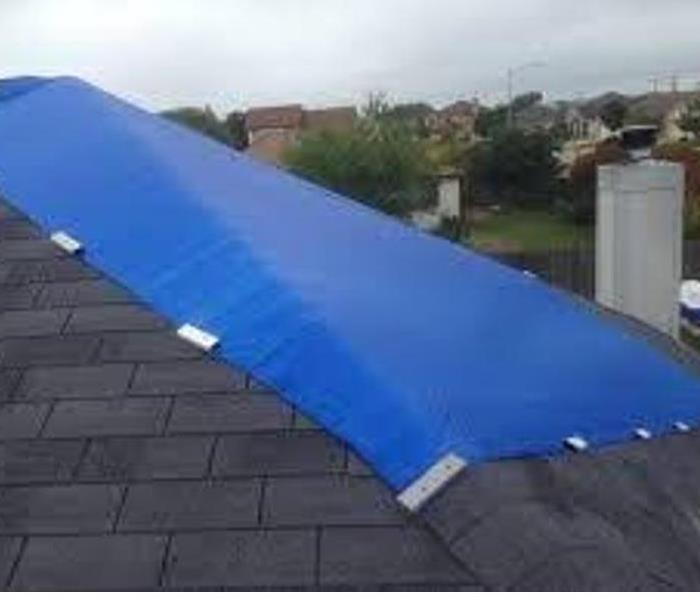 If Your Roof is Leaking You May Need a Roof Tarp
If Your Roof is Leaking You May Need a Roof Tarp
Emergency tarping is needed when unwanted debris causes harm to your roof. For example, if a tree falls and causes a hole in your roof, it will cause a leak if it rains. This will create the need for a roof tarp to prevent further damage from taking place in the home. There also may be situations where we are able to find out that your ‘roof leak’ was actually an air conditioning unit leak or problem. If there is damage to the inside of your home, from a roof leak, or another kind of ceiling leak, you may need emergency services.
Another way to know if you need to contact SERVPRO of Streamwood, Bartlett, West Chicago, & Warrenville for a roof tarping is by checking ceilings for damage. If a ceiling is damaged from a leak, it will only get worse. If a continues to happen without being fixed, you’ll notice ceiling damage to get worse in your home. If you notice any staining, you can generally see where the staining has gotten worse through time because it will begin to look like rings on a tree. Just like you can tell how old a tree is by its rings, it’s possible to see how many times there have been leaks in the same area. Not only can this affect the home’s roof structure and ceiling. It may create secondary damage if moisture stays present and is never dried out properly.
Roof leaks are common, and also avoidable. They are most common where there are flashings. Flashing is simply where the surface of the roof may change. Like where a chimney or valley may be in the roof. It is important to focus on preventative measures in order to avoid damage to these areas and the rest of the roof.
Colder Temps are Coming: Be Prepared
9/28/2020 (Permalink)
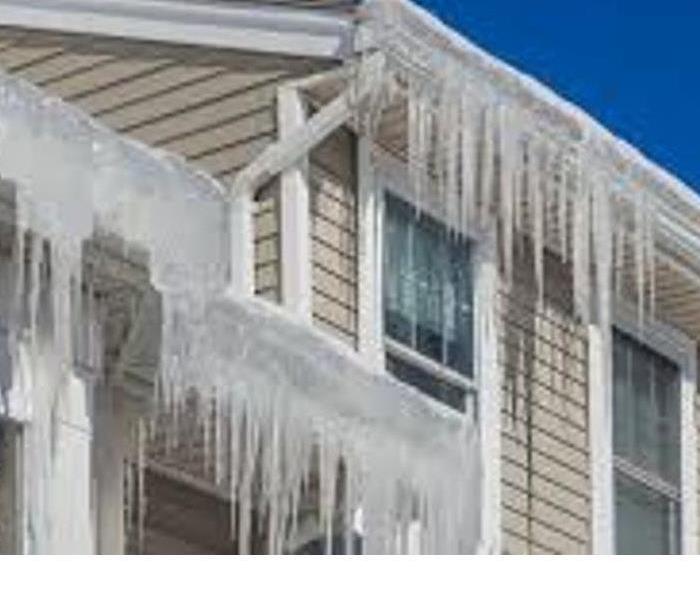 Know How To Deal with Ice Dams
Know How To Deal with Ice Dams
The wintertime presents some very unique challenges for your home, the most glaringly obvious being Ice Dams. An ice dam is a wall of ice that forms at the edge of a roof, preventing water from properly draining. As a result, water can begin to back up under the shingles and eventually infiltrate the home. This can cause water damage to walls, ceilings, insulation and so much more. And if not dealt with in a timely manner, this water damage can even lead to mold and mildew, which can cause a number of health-related effects.
Dealing with Ice Dams and the Resulting Water Damage
1. Remove Snow: Step 1 is to remove any excess snow from your roof. This will prevent water from building up and leaking into your home. And if water has already found its way into your home, it will help prevent further water damage.
2. Allow Proper Water Flow: If water has already built up behind an ice dam, chip away a channel through the ice dam to allow water to drain from your roof.
3. Call SERVPRO of Streamwood, Bartlett, West Chicago & Warrenville: If water has found its way into your home as the result of an ice dam, let the SERVPRO water damage restoration professionals help. With over 15 years of experience, we know how to get the job done right!
Colder Temps are Coming: Be Prepared: Part II
9/28/2020 (Permalink)
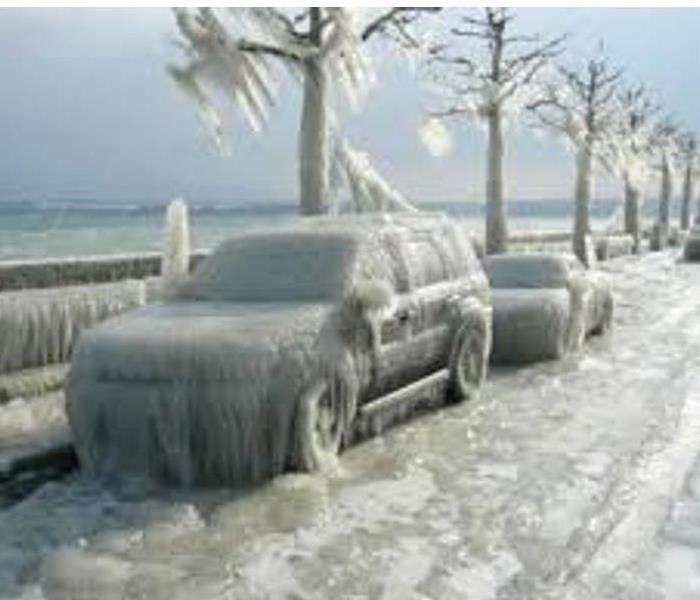 Be prepared as colder tempatures near the Bartlett area
Be prepared as colder tempatures near the Bartlett area
An ice storm can be one of the most devastating winter storms. Ice storms are caused when a winter event starts as snow in the upper atmosphere. As the snow travels into warmer air it melts into rain droplets. The rain then hits the frozen ground and refreezes. This ‘frozen rain’ can quickly accumulate and entomb everything in the landscape with a glaze of ice so heavy that it can split trees in half and turn roads and sidewalks into lethal sheets of thick, smooth ice. The results are fallen trees and branches, sagging or down power lines, treacherous, and driving conditions that can cause severe accidents. But the worst part of these storms is the massive power outages they can cause.
In preparation for what might be a rain/snow/ice event, there are several things you can do to prepare.
Always keep a supply of non-perishable food items and water (don’t forget a hand opener for canned goods).
Have extra blankets at the ready.
Always keep an extra supply of batteries on-hand.
Check flashlight to make sure they are operational and have a battery-powered radio.
To prevent water pipes from freezing, keep faucets turned on slightly to create a slow drip. Also, know where your main water valve is in your house in case you need to shut it off if a water pipe does burst.
Keep these supplies in a central location where everyone knows to find them in the dark.
Some other things to consider might be putting any prescription drugs, special items, and a first aid kit in a central location. If you are going to use an alternate heat source, make sure to follow all manufacturer's safety guidelines.
PROTECTING YOUR HOME FROM STORM DAMAGE
9/23/2020 (Permalink)
 With the rainy season approaching, protect your home from storm damage
With the rainy season approaching, protect your home from storm damage
We are quickly approaching fall, which means the potential for serious storms in September and October. You don’t have to wait for the rainy season to start preparing your home. There are a few simple tips you can follow so you can protect your home from storm damage.
Trim Trees
If you want to protect your home from storm damage, you want to start with your landscape. One of the biggest threats towards your home during a storm is weak or dead tree branches. The last thing you want is for a branch to fly off a tree and right into one of your windows during a storm. If that were to happen when no one was home, that could result in serious water damage. So, all you have to do is trim any branches that are hanging over or near your home, especially if they are dead.
Seal Windows and Doors
When it comes to protecting your home during a storm, you want to make sure every entryway in your home is tightly sealed. Inspect each of your windows and doors in your home to make sure they are insulated properly. There are several ways to enhance your windows including install storm shutters and high-impact glass. There are also double-paned models that are effective during storms, as well as, energy-efficient.
Don’t Forget Your Roof
It is essential that your roof is into exceptional conditional because it is one of the major protective layers of your home. You want to check around your chimney and vent pipes to see if you need to apply a sealer. Make sure your gutters are clear of all leaves and debris, especially before a storm hits. The last thing you want is for your gutters to clog and water to overflow damaging the foundation of your home.
What to Do to Protect Your Home Before Storms Occur
9/21/2020 (Permalink)
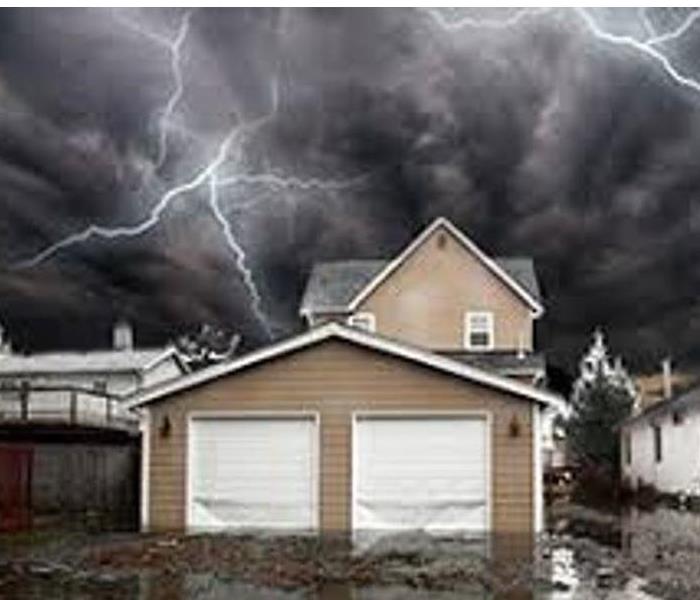 Protect your home and assests from potential storm damage
Protect your home and assests from potential storm damage
1. Update Insurance Policies
One of the easiest things a homeowner can do to prepare for seasonal storms is to look over current insurance policies to assure coverage of losses from storms or natural disasters. Earthquakes, floods, and hurricanes aren’t normally covered under homeowner policies but can be covered in other specific policies. Knowing your policies can help you make preparations to stay eligible for insurance claims.
2. Protect Windows
To avoid costly hail damage, keep the elements from penetrating windows, exterior cracks, entryways, and garage doors. Make sure windows and doors are sealed securely and, if needed, attach storm shutters to windows.
3. Install Steel Doors
For storm protection, installing steel doors can make a difference. Strong, tornadic winds can tear through the weak doors of a home, leaving little protection for your home interior from the storm’s effects. Steel doors with adequate support can stop that from happening.
4. Care for Roofing
Inspecting and maintaining your roof year-round is important for preventing storm damage. Remove ice and snow during the winter, and clear away fallen leaves and tree branches during autumn to keep your roof free from damaging debris. Have a professional roofing contractor check your roof before the storm season.
5. Inspect Foundation
Protecting your home’s foundation can make you better prepared to avoid storm damage. Notice cracks in ceilings or walls, gaps or separations, like windows no longer fitting their frame. Go through your basement or crawl space and see if there are any zigzag-patterned cracks along mortar lines. If you see any of these, contact a professional. A solid home foundation is of utmost importance during storms.
6. Trim Landscaping
A simple way to protect your home’s roof, windows, and doors from the need for hail damage repair is to attend to any loose or dead tree limbs or shrubbery. A strong wind combined with a heavy tree limb could cause damage to the home and even be life-threatening. Additionally, bushes that are not firmly planted can create destructive debris during a heavy storm.
7. Clear Gutters
Nobody likes cleaning gutters. It’s a pain to drag the ladder out, put on a pair of gloves, and start climbing. But the problem is that the gunk and grime filling up your gutters block hail and stormwater from running off your roof. When anything settles on your roof too long, it causes irreversible damage that could have easily been avoided with a clean gutter system.
8. Store Yard Furniture
Anything loose in your yard can be lifted into the air during a storm. Pick up any tree limbs lying on the ground. Secure lawn furniture and yard ornaments or store them when not in use. Even flowerpots can blow away if light enough. High-speed winds during a severe storm can cause damage to windows and other exterior features, like siding and garage doors, if everything isn’t solidly secured to the ground.
9. Plan for an Emergency
During a seasonal storm, it is important to plan for all possibilities. If your electricity fails, flashlights, extra batteries, a radio, or a backup generator can all be important things to have, especially during emergencies caused by storm damage. Stocking up with anything you might need when battening down the hatches, like blankets, non-perishable food items, and bottled water, can even prove lifesaving during the worst storms.
Its Windy Out
6/7/2018 (Permalink)
Straight-line wind is a term used to define any thunderstorm wind that is not associated with rotation, and is used mainly to differentiate from tornado winds.
- Downdraft is a small-scale column of air that rapidly sinks toward the ground.
- Down burst is a result of a strong downdraft. A down burst is a strong downdraft with horizontal dimensions larger than 4 km (2.5 mi) resulting in an outward burst of damaging winds on or near the ground. (Imagine the way water comes out of a faucet and hits the bottom of the sink.) Down burst winds may begin as a micro burst and spread out over a wider area, sometimes producing damage similar to a strong tornado. Although usually associated with thunderstorms, down bursts can occur with showers too weak to produce thunder.
- Microburst is a small concentrated down burst that produces an outward burst of damaging winds at the surface. Micro bursts are generally small (less than 4 km across) and short-lived, lasting only 5-10 minutes, with maximum wind speeds up to 168 mph. There are two kinds of micro bursts: wet and dry. A wet micro burst is accompanied by heavy precipitation at the surface. Dry micro bursts, common in places like the high plains and the inter-mountain west, occur with little or no precipitation reaching the ground.
- Gust front is the leading edge of rain-cooled air that clashes with warmer thunderstorm inflow. Gust fronts are characterized by a wind shift, temperature drop, and gusty winds out ahead of a thunderstorm. Sometimes the winds push up air above them, forming a shelf cloud or detached roll cloud.
- Derecho is a widespread, long-lived wind storm that is associated with a band of rapidly moving showers or thunderstorms. A typical derecho consists of numerous micro bursts, down bursts, and down burst clusters. By definition, if the wind damage swath extends more than 240 miles (about 400 kilometers) and includes wind gusts of at least 58 mph (93 km/h) or greater along most of its length, then the event may be classified as a derecho.
Flooding and Recovery
6/7/2018 (Permalink)
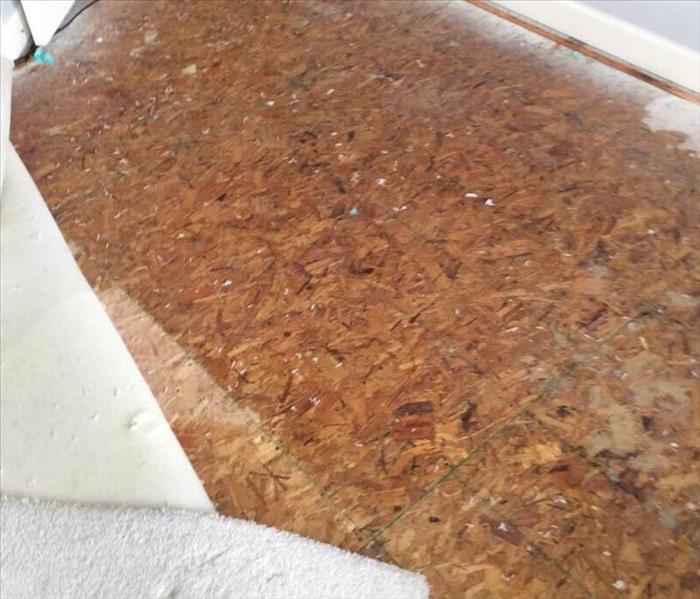
How can a roof leak and roof damage escape easy detection in this situation? Wind damage may loosen flashing, eventually causing another roof leak weeks after the storm. Even a subtle roof leak of this nature can produce damp, moldy conditions inside the home. Obtaining fast roof repair may prevent long term interior damage. A wind damage home restoration expert may assist clients in receiving comprehensive roof assessments and roof repair services when hurricane damage afflicts an area. Their expertise helps property owners address storm damage and roof damage more effectively. Flood water frequently poses a risk in coastal areas. Yet heavy rains may cause river flooding miles inland also. If the surrounding terrain cannot absorb ground water, runoff contributes to flood water. Even residents of mountainous areas sometimes sustain varying degrees of flood damage if frozen pipes rupture. Flood pump failures contribute to basement flooding and contaminated ground water in some locations, too. Flooding may disrupt municipal water systems. Experts need to assess ground water and evaluate the condition of pipes following flood damage. Hiring a storm restoration firm may allow you to begin your cleanup process even before water restoration occurs. (Cleaning before water restoration often proves essential yet challenging.) By relying upon a trained specialist, you'll usually obtain faster storm remediation. These experts may suggest ways to help mitigate flood water damage in the future, for instance, by requesting backup flood pump installation.
SERVPRO of Streamwood/ Bartlett/ West Chicago City is Ready
6/5/2018 (Permalink)
SERVPRO of Streamwood, Bartlett and West Chicago City specializes in storm and flood damage restoration. Our crews are highly trained and we use specialized equipment to restore your property to its pre-storm condition.
Faster Response
Since we are locally owned and operated, we are able to respond quicker with the right resources, which is extremely important. A fast response lessens the damage, limits further damage, and reduces the restoration cost.
Resources to Handle Floods and Storms
When storms hits Streamwood, Bartlett and West Chicago City, we can scale our resources to handle a large storm or flooding disaster. We can access equipment and personnel from a network of 1,650 Franchises across the country and elite Disaster Recovery Teams that are strategically located throughout the United States.
Have Storm or Flood Damage? Call Us Today
Streamwood, Bartlett and West Chicago City 630-562-9212
Storm Emergency Services
6/5/2018 (Permalink)
Residential Services
Whether your Streamwood/ Bartlett/ West Chicago City home needs emergency flood damage or roof tarping, you can depend on us. Our technicians have extensive cleaning and restoration training and can make your property look its best. Learn more about our residential services:
- Building/Reconstruction ServicesThere's never a good time for fire or Water damage to strike your Streamwood/ Bartlett/ West Chicago City commercial property. Every hour spent cleaning up is an hour of lost revenue and productivity. So when the need arises for professional cleaning or emergency restoration services SERVPRO of Streamwood/ Bartlett/ West Chicago City has the training and expertise to respond promptly with highly trained technicians to get your property back to business. Learn more about our commercial services.
- Commercial Services
Water Damage Breakdown
6/5/2018 (Permalink)
Within Minutes
- Water quickly spreads throughout your property, saturating everything in its path.
- Water is absorbed into walls, floors, upholstery, and belongings.
- Furniture finishes may bleed, causing permanent staining on carpets.
- Photographs, books, and other paper goods start to swell and warp.
Hours 1 - 24:
- Drywall begins to swell and break down.
- Metal surfaces begin to tarnish.
- Furniture begins to swell and crack.
- Dyes and inks from cloth and paper goods spread and stain.
- A musty odor appears.
48 Hours to 1 Week:
- Mold and mildew may grow and spread.
- Doors, windows, and studs swell and warp.
- Metal begins to rust and corrode.
- Furniture warps and shows signs of mold.
- Paint begins to blister.
- Wood flooring swells and warps.
- Serious biohazard contamination is possible.
More Than 1 Week:
- Restoration time and cost increase dramatically; replacing contaminated materials and structural rebuilding may be extensive.
- Structural safety, mold growth, and biohazard contaminants pose serious risks to occupants.
Thunderstorm Facts
6/5/2018 (Permalink)
Facts about Thunderstorms
- They may occur individually, in clusters or in lines.
- Some of the most severe occur when a single thunderstorm affects one location for an extended time.
- Thunderstorms typically produce heavy rain for a brief period, anywhere from 30 minutes to an hour.
- Warm, humid conditions are highly favorable for thunderstorm development.
- About 10 percent of thunderstorms are classified as severe – one that produces hail at least an inch or larger in diameter, has winds of 58 miles per hour or higher or produces a tornado
- Facts about Lightning
- Lightning’s unpredictability increases the risk to individuals and property.
- Lightning often strikes outside of heavy rain and may occur as far as 10 miles away from any rainfall.
- “Heat lightning” is actually lightning from a thunderstorm too far away from thunder to be heard. However, the storm may be moving in your direction.
- Most lightning deaths and injuries occur when people are caught outdoors in the summer months during the afternoon and evening.
- Your chances of being struck by lightning are estimated to be 1 in 600,000 but could be reduced even further by following safety precautions.
- Lightning strike victims carry no electrical charge and should be attended to immediately.Familiarize yourself with these terms to help identify a thunderstorm hazard:Severe Thunderstorm Watch- Tells you when and where severe thunderstorms are likely to occur. Watch the sky and stay tuned to NOAA Weather Radio, commercial radio or television for information.
- Severe Thunderstorm Warning- Issued when severe weather has been reported by spotters or indicated by radar. Warnings indicate imminent danger to life and property to those in the path of the storm.
- Know the Terms





 24/7 Emergency Service
24/7 Emergency Service
























